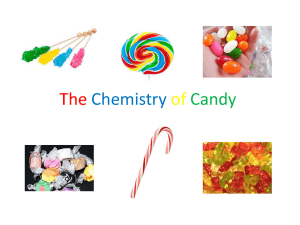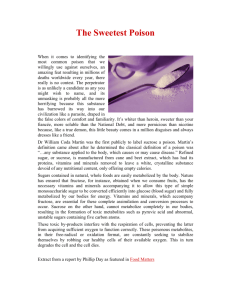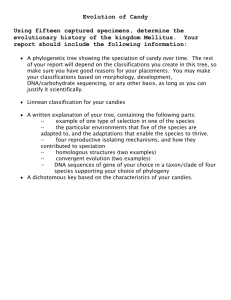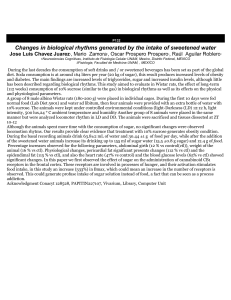Carbohydrates, sugar solutions, and candies Solutions Solubility
advertisement
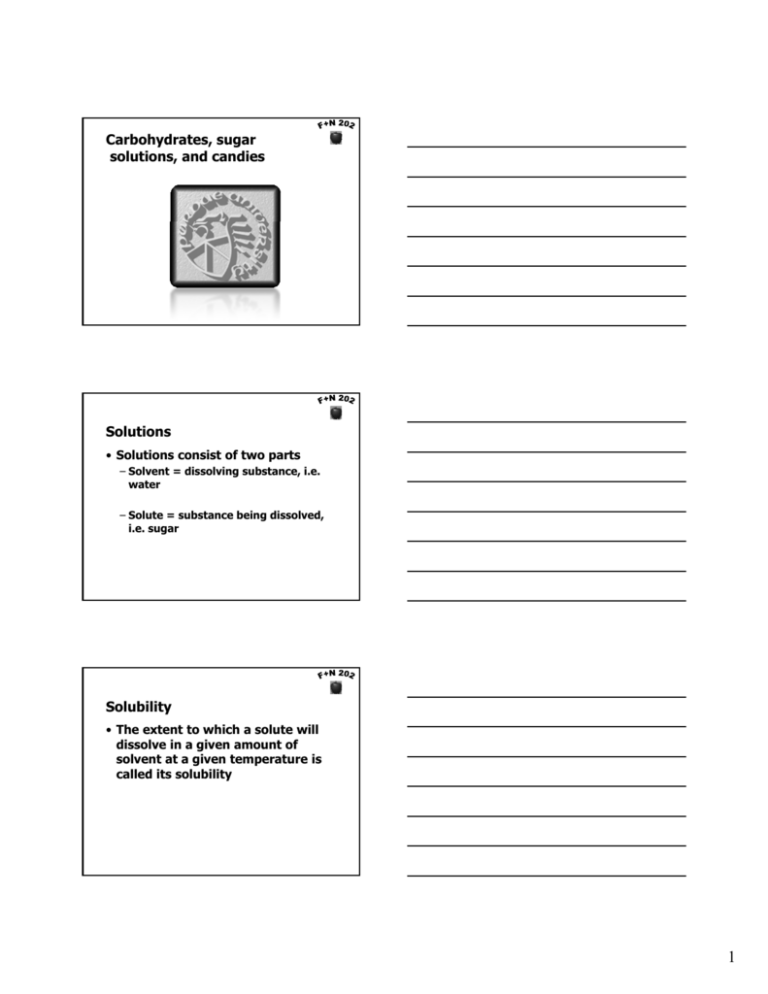
Carbohydrates, sugar solutions, and candies Solutions • Solutions consist of two parts – Solvent = dissolving substance, i.e. water – Solute = substance being dissolved, i.e. sugar Solubility • The extent to which a solute will dissolve in a given amount of solvent at a given temperature is called ll d its it solubility l bilit 1 Solution characteristics • Solutions are homogeneous • Solutions do not separate over time Solubility depends on • Temperature – As temperature increases, the solubility of solids (but not gasses) in water increases – Sugar g ((0oC): ) 179g g ; Sugar g ((100oC): ) 487g g • Characteristics – “like dissolves like” – water dissolves polar things, oil dissolves non-polar things Solubility depends on • Presence of other ingredients Tea + hot water Tea beverage cool “Scum” is dissolved Lemon juice (acid) “Scum” formation insoluble tannin complex 2 Rate of dissolving depends on • Particle size – The smaller the particle, the larger the surface area, the faster it dissolves 96 sq in, a 16 fold increase 6 sq in Larger surface area Smaller surface area Colligative properties • These are properties which depend on the number of dissolved particles, not on what those particles ti l are – Boiling point elevation • Candy – Freezing point depression • Frozen desserts Boiling point elevation and freezing point depression BP2 BP1 BP = 100C FP = 0C Solvent H 2O FP1 Solution FP2 More concentrated solution Increasing solute concentration 3 Candy and carbohydrates • Carbohydrates – Monosaccharides/disaccharides – Market forms of sugars – Market forms of syrups – Properties of sugars Candy and carbohydrates • Candy making – Crystalline candy – Crystal size – Solution saturation • Interfering agents – Non-crystalline candy – Maillard browning Monosaccharides • Glucose – Most common sugar in nature – Also called dextrose • Fructose – Sweetest natural sugar – Main sugar in honey 4 Disaccharides • Maltose – Two glucoses – Found in corn syrup • Lactose – Glucose and galactose – Milk sugar • Sucrose (table sugar) – Glucose and fructose – From sugar cane or sugar beet Sugars -- Market forms • Granulated – Crystalline sucrose • Brown – Sucrose with a coating of molasses • Powdered – Finely ground granulated with anticaking agent • Invert – Hydrolyzed sucrose Invert sugar H2O Glucose--Fructose Glucose + Fructose Acid or enzyme Invert sugar 5 Market forms of syrups • Molasses – From sucrose processing Molasses Sucrose Molasses Market forms of syrups • Corn syrup Starch Glucose + Maltose + Dextrins • High fructose corn syrup (HFCS) Corn syrup Glucose + Fructose + Maltose + Dextrins Glucose isomerase 6 Market forms of syrups • HFCS has the advantages over sucrose that it is sweeter and cheaper • Maple syrup Sap 40 gallon heat Syrup 1 gallon The distinctive flavor of maple syrup is developed during the boiling down process Market forms of syrups • Honey – High in fructose (the sweetest natural sugar) 38% fructose, 31% glucose • Sorghum – Similar to molasses • Lightning Quiz Sugar properties • Action of water – Most sugars are water soluble • Sucrose>>>Lactose • Fructose>>Glucose, F t >>Gl G Galactose l t • Most sugars are hygroscopic – They attract water to themselves (due to so many OH groups in the sugar structure) 7 Sugar properties • Effect of heat – Sugars melt, then caramelize at higher temperatures • Effect of acids or enzymes – Acids and enzymes (sucrase, invertase ) will convert sucrose to invert sugar – The enzymes of yeast will convert sucrose to alcohol and carbon dioxide Candy making • Aim: To produce small sucrose crystals • In candy and frozen desserts, crystal size is texture • Endpoint cooking temperature is of extreme importance as this determines the concentration of sugar in the syrup • Thermometer must be calibrated Animation Candy making Heating End point temp Cooling Unsat. Saturation Unsat. Room temp Supersaturated Room temp 8 Candy making • To form sugar crystals (candy) you must be in the supersaturated region • The question is, where in the supersaturated region do you induce crystallization? Crystallization Induce here Induce here Room temp Room temp Crystallization • Remember that the aim in making crystalline candy is to make small crystals • Thus, we want to induce crystallization just a little above room temperature to maintain small crystal size and smooth texture 9 Controlling candy crystal size • Cook to correct endpoint temperature – Calibrate thermometer! • Make sure all sucrose is in solution x Controlling candy crystal size • Cool to correct degree of supersaturation • Add interfering agents – Fats Fats, oils butter, butter chocolate (protein and fat), fat) milk (protein and fat), gelatin (marshmallows), food gums, eggs, (protein and fat), syrups (corn syrup, HFCS, invert sugar) – All these things are non-crystalline and interfere with the growth of sugar crystals Crystalline candies • Fudge • Fondant • Divinity 10 Non-crystalline candies • Rock candy – High temperature • Lollipops – High temperature • Butterscotch – High temperature Non-crystalline candies • Peanut brittle – High temperature • But, peanut brittle has an ingredient that no other candy has An odd ingredient? • 1 pint Karo, Blue Label 1 cup granulated sugar 1/4 teaspoon vanilla 1/3 tteaspoon b baking ki soda d 2 cups roasted peanuts 11 Baking soda in peanut brittleWhat does it do? • Neutralizes acids produced by thermal degradation of sugar; this improves the taste of the candy • When it neutralizes the acids, carbon dioxide is trapped in the candy matrix; this improves the texture • Baking soda changes the pH of the candy and this causes changes in the browning pigments; this improves the color Non-crystalline candies • Caramels – Are caramel colored due to Maillard browning – This is a reaction between p protein and sugar g at high temperature that produces pigments, aromas, and flavors – Caramels are non-crystalline because of the large amount of interfering agents used in the recipe Non-crystalline candies • Taffy – Uses both high temperature and lots of interfering agents to remain noncrystalline 12 Chocolate covered cherries time Acids and/or enzymes called ll d sucrase or invertase i t Fondant, a solid Lightning Quiz Liquidy coating? How did this happen? 13
